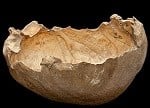Britons ate each other, probably as part of mortuary practice about 15,000 years ago, a new study on the human remains from Gough’s Cave in Somerset has shown. Researchers from University College London, the Natural History Museum in London, and a number of Universities in Spain report that early Britons had cannibalistic habits.
Ancient human burial sites are very rare. However, anthropologists have unearthed several ancient human remains over the years, dating back about 15,000 years from Gough’s Cave, located in Cheddar Gorge on the Mendip Hills in Cheddar, Somerset, England.
These bones have been carefully studied, and research has been published, including some four years ago where Natural History Museum scientists revealed that the earliest known examples of human skull-cups were made in Britain.

Damage on a rib bone caused by human chewing, showing breaks made by saw-teeth (white arrows), dug out furrows (B), and slicing cut marks (C). Scale bar = 250 μm. (Image: nhm.ac.uk)
This latest study found cannibalistic evidence, including human tooth marks on several of the human bones.
Early Britons were skilled butchers
The researchers report that 15,000 years ago in Britain there was a sophisticated culture of butchering and carving of human remains.
Lead researcher, Dr Silvia Bello, who works at the Natural History Museum’s Department of Earth Sciences, said:
“We’ve identified a far greater degree of human modification than recorded in earlier research.”
“We’ve found undoubting evidence for defleshing, disarticulation, human chewing, crushing of spongy bone, and the cracking of bones to extract marrow.”
Radiocarbon dating showed the remains were deposited over a fairly short period of time, maybe during a series of seasonal occupations, approximately 14,700 years ago.

A Human skull-cup found in Gough’s Cave. (Image: nhm.ac.uk)
The evidence suggests that people returned to the area, possibly for hunting or burying their dead.
The early humans living at Gough’s Cave 14,700 years ago were Magdalenians, a cultural group of foragers who originated in southwest Europe.
They probably migrated to Britain from the Netherlands or Belgium as the climate turned warmer about 15,000 years ago after the last Ice Age.
Part of a mortuary practice
Evidence of humans eating each other has been found in other ancient sites in western and central Europe. However, this study suggests that cannibalism was part of a mortuary practice that included the ritual use of skull-cups, and the intensive processing and consumption of the bodies.
Research team member, Simon Parfitt, who works at UCL’s Institute of Archerology, said:
“Further analysis along the lines used to study Gough’s Cave will help to establish whether the type of ritualistic cannibalism practiced there is a regional (‘Creswellian’) phenomenon, or a more widespread practice found throughout the Magdalenian world.”
Neanderthals probably ate their dead children
Researchers from the University of Bordeaux in France found evidence that Neanderthals probably ate their dead children, as well as the carcasses of adults about 57,600 years ago.
A study found signs that they cut, beat and fractured the bones of recently-deceased companions.
Neanderthals were a species of human in the genus Homo (extinct). They only differed from modern humans in their DNA by 0.12%.
According to an analysis of the specimens discovered in the Poitou-Charentes region of France, cuts were made soon after death to separate limbs from the body.

